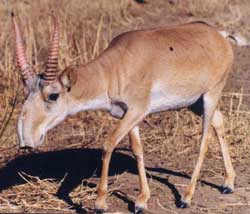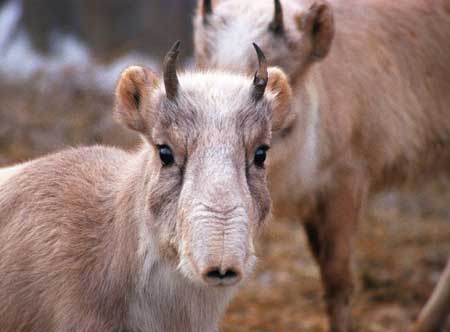Saiga antelope
The scientific name is Saiga tatarica, many in Mongolia, Kazakhstan and Kalmykia region (Russia). Saiga antelopes belong to herbivores, they choose to eat on a hundred different types of grass.

Saiga - male (Photo: redlist)
Their bodies look sturdy, strong, short tails. The cry is almost like a cow. Males have long horns, these horns are very strange: colored like wax and look like small rings attached along the horn.
Saiga antelope weighs 30-45kg, shoulder height is about 0.6-0.8m; my body is about 1-1.5m long. The most striking feature is that they have a large head with an easy-to-move nose, which looks like a small nozzle. Many people think that their strange nostrils can be adapted to harsh climatic conditions: make the monkey moist and warm before entering the lungs.
Saiga's fur also has strange adaptive characteristics. In the summer, the coat is shorter, and in this season, their backs and necks are slightly yellowish, the belly is lighter in color. The hottest times of the day they just stay in place and never move anywhere until the sun goes down. But in the winter they are active again all day, in cold weather their feathers grow to become thicker and longer. The coat turns gray on the back and neck, the belly is gray brown.
Females mature at 7-8 months, while males must be 2 years old to reach adulthood. Breeding season is from the end of November to the end of December, children are 5 months pregnant and often give birth to only 2 calves each.
Saiga antelope is a true polygamy . In the breeding season, they gather in groups, each group has 5-10 children and only one male. Males are very interested in protecting their "wives" . In this season, adult males often fight against each other, but they do not kill each other.
Many males do not eat grass during the breeding season and use almost all their strength to fight off the "enemy". As a result, at the end of the breeding season, adult males become weak and often die 80-90%.

(Photo: christine73.canalblog)
After the breeding season, Saiga antelope together again to form large herds of 30-40 children, they migrate to avoid snowstorms or droughts. At this time, it was crowded but there was no first-born child.
Their feathers, meat and horns are very valuable. The horns are about 28-30cm long and are most valuable, often crushed by humans to reduce fever.
Previously, this antelope was very carefully protected by the Soviet Union, but now the number is decreasing significantly due to excessive hunting.
- The mystery caused 85,000 Saiga antelope deaths
- Find the culprit causing 200,000 Saiga antelope to die in a month
- Russian airship is suspected of killing antelope
- Tiny antelope
- Close up of hungry harpooning to rejuvenate young antelope
- The old antelope wisely escaped death before the hyenas
- Marvelous paradise on a mountain range
- The giant antelope in Mongolia
- The extremely rare Bongo antelope was born in England
- Unbelievably strange animals
- The attack on the antelope is 20 times larger, the molasses is knocked flying
- The antelope scares the lion
 Animal 'suffering' after hibernation
Animal 'suffering' after hibernation Why do goats climb well?
Why do goats climb well? Scientists were surprised to see chimpanzees eating turtles
Scientists were surprised to see chimpanzees eating turtles Giant catfish died deadly due to drought in Thailand
Giant catfish died deadly due to drought in Thailand The year is not over yet, but the 2024 storm season is already full of records, every storm seems to be 'fast-charged'
The year is not over yet, but the 2024 storm season is already full of records, every storm seems to be 'fast-charged'  Why do humans have no mating season?
Why do humans have no mating season?  Why are early season food expensive like gold that Japanese people still compete to buy?
Why are early season food expensive like gold that Japanese people still compete to buy?  8 things are most happening on the day of the season
8 things are most happening on the day of the season  Giant dinosaurs dug out of the cave
Giant dinosaurs dug out of the cave  Amazon forest leaves call the rainy season coming soon
Amazon forest leaves call the rainy season coming soon 